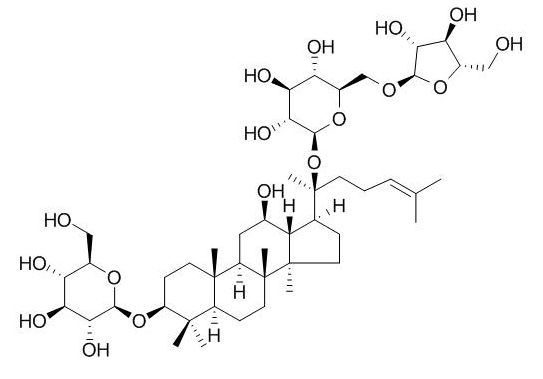Notoginsenoside Fe can induce gap junction-mediated intercellular communication (GJIC) reductions; and gap junctions have been shown or are believed to be involved in the pathogenesis of many inherited and acquired human diseases, agents that regulate the GJIC function may facilitate prevention and treatment of GJIC-involved diseases.
Providing storage is as stated on the product vial and the vial is kept tightly sealed, the product can be stored for up to
24 months(2-8C).
Wherever possible, you should prepare and use solutions on the same day. However, if you need to make up stock solutions in advance, we recommend that you store the solution as aliquots in tightly sealed vials at -20C. Generally, these will be useable for up to two weeks. Before use, and prior to opening the vial we recommend that you allow your product to equilibrate to room temperature for at least 1 hour.
Need more advice on solubility, usage and handling? Please email to: service@chemfaces.com
The packaging of the product may have turned upside down during transportation, resulting in the natural compounds adhering to the neck or cap of the vial. take the vial out of its packaging and gently shake to let the compounds fall to the bottom of the vial. for liquid products, centrifuge at 200-500 RPM to gather the liquid at the bottom of the vial. try to avoid loss or contamination during handling.
Planta Med., 2001, 67(5):417-22.
Effects of ginsenosides from Panax ginseng on cell-to-cell communication function mediated by gap junctions.[Pubmed:
11488454]
Gap junctions have been shown or are believed to be involved in the pathogenesis of many inherited and acquired human diseases. Agents that regulate the gap junction-mediated intercellular communication (GJIC) function may facilitate prevention and treatment of GJIC-involved diseases.
METHODS AND RESULTS:
In the present study we examined the effects of 27 ginsenosides isolated from Panax ginseng on GJIC. The results show that compounds 1 (oleanolic acid), 2 (ginsenoside-R0), 3 (ginsenoside-Rb1), 5 (ginsenoside-Rb2), 7 (ginsenoside-Rd), 8 (ginsenoside-Rg3), 12 (panaxadial), 13 (notoginsenoside-R4), 17 [ginsenoside-Rg2 (20S)], 18 (ginsenoside-Rf), and 26 (ginsenoside-F3) did not obviously affect GJIC, whereas compounds 4 (ginsenoside-Rc), 6 (ginsenoside-Rb3), 9 (ginsenoside-Rd2), 10 (Notoginsenoside Fe), 11 (ginsenoside-Rh2),14 (ginsenoside-Ra1), 15 (ginsenoside-Re), 16 [ginsenoside-Rg2 (20R)], 19 (ginsenoside-Ia), 20 [ginsenoside-Rh1 (20S)], 21 [ginsenoside-Rh1 (20R)], 22 (ginsenoside-F1), 23 (protopanaxatriol), 24 (panaxatriol), 25 (ginsenoside-Rg1), and 27 (chikusetsaponin-L8) induced GJIC reductions at various degrees. Compounds 2, 7, and 8 protected against the tyrosine phosphatase inhibitor vanadate-induced GJIC reduction, while compounds 1, 5, 7, and 17 inhibited the cytokine interleukin 1 alpha (IL-1alpha)-induced reduction in GJIC. Nevertheless, no compounds protected against the protein kinase C (PKC) activator 12-O-tetradecanoylphorbol-13-acetate (TPA)-induced GJIC inhibition. On the other hand, GJIC reductions induced by compounds 6, 9,10, 20, 21, 22, 24, and 25 were inhibited by the tyrosine kinase (TK) inhibitor genistein, while GJIC reductions induced by compounds 6, 9, 14, 16, 19, 21, and 24 were attenuated in the presence of the PKC inhibitor calphostin C. However, GJIC reductions induced by compounds 4, 23, and 27 were not inhibited either by genistein or by calphostin C.
CONCLUSIONS:
These data indicate that various mechanisms are responsible for effects of ginsenosides on GJIC.



